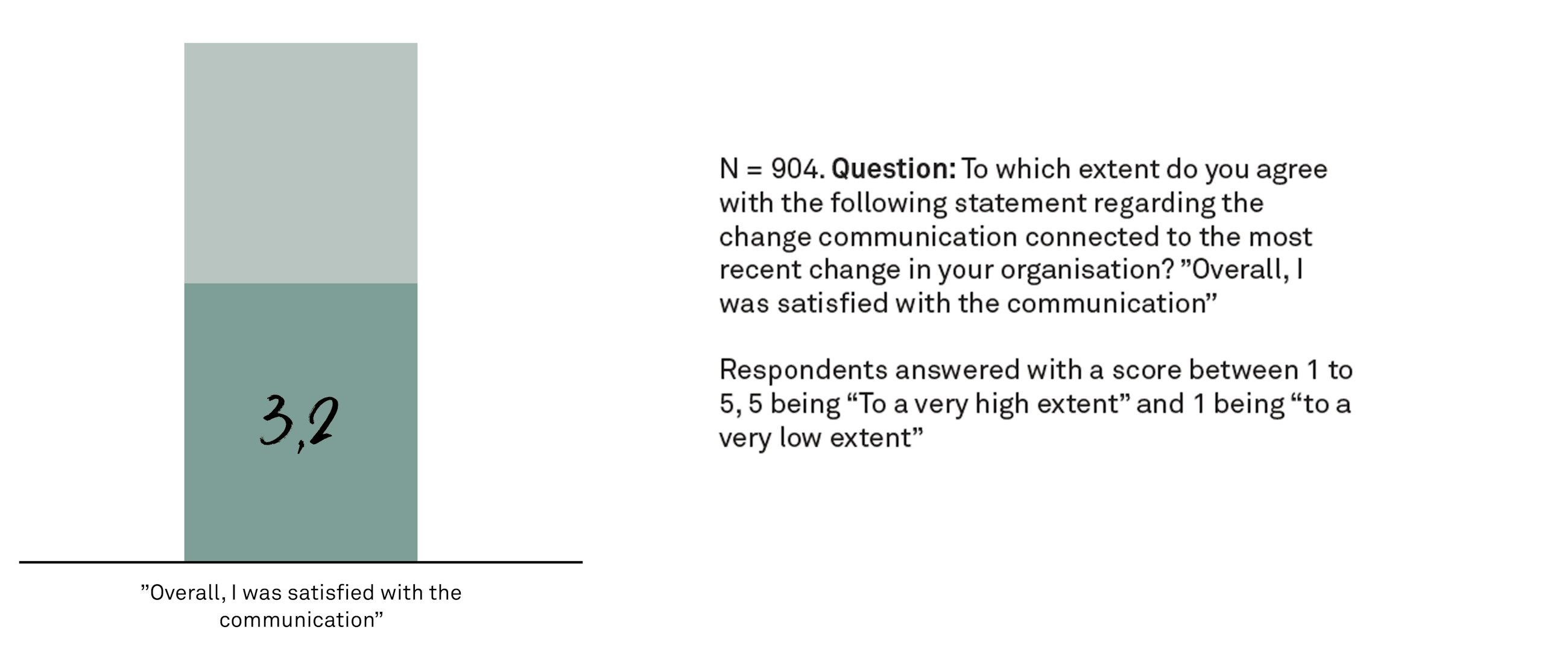A health check on organisational change communication
10 November 2022
It is not always about you!
The diagnosis: A scrappy state of health
What was once an underappreciated insight is now becoming a well-established truth: To make change happen, you need to engage the people who are impacted by it. And communication is a crucial step in realising this objective.
So, how are we doing on that? What is the state of health of change communication across European organisations?
Our biannual survey, Change Communication X-ray, is a health check. Instead of questions about lifestyle and blood circulation, we asked leaders and employees about the state of change communication in their organisation.
The diagnosis is clear: Change communication is in a scrappy state of health.
When we asked respondents to rate their experience with the most recent change in their organisation, they scored communication at an average of 3.2 out of 5. This score is quite frankly disturbing when you believe in communication as a key enabler of change.
As we will see in this report, the ailing health of change communication exhibits many symptoms. Looking across them all, we have identified one root cause:
We seem to have forgotten that communication is spelled with a “you”.
What is Change Communication?
Change communication is the strategic communication activities carried out inside organisations to engage employees and leaders with the purpose of motivating them to adopt new behaviour associated with a given change.
Taking employees for granted
When asking people which word or phrase they wish to hear more in change communication, many point to one simple word: “you”. Below are some of the statements that support this observation.
“I would like to hear the phrase: ‘We have thought about your needs and situation. We would like to engage you and hear your opinion.’”
“It would be good to hear more ‘you’ in the communication: More direct communication about what we – the employees – win from a change and why we should prioritise to engage.”
“The phrase: ‘what do you think?’ is something I would like to hear more often.”
This resonates with our observations from hundreds of change projects. Again and again, we see how internal communicators focus on the hard factors: The ERP system, the new process in Customer Service, the 5 must-win battles of the strategy. Communication becomes system-centric, rather than people-centric. The problem: This terminology misses the fact that it is behaviour that drives change – not the other way around.
If we want people to act, we must inspire them. Just think of external communication to consumers. Companies here build their messaging around insights-driven content, and they care deeply about the emotional lives of their target groups. In other words: they put the people they want to inspire to act at the centre of communication.
When communicating internally, on the other hand, many organisations tend to forget that people should be at the centre of attention. They do not listen to the employees’ emotions regarding the change or give the individual a clear role in the story of change.
Instead, we see how organisations – sometimes without even noticing it – take their employees’ support and engagement for granted. Well, here’s the bad news about that: Just because people receive a pay cheque every month doesn’t mean they automatically applaud every change they are exposed to.
This approach leaves employees unhappy with the process as well as the result. So, make sure to address the element of “What does this mean to you” in your communication.
Bringing YOU back: Three paradoxes to navigate
Changing the mind, heart and behaviour of people isn’t a rational step-by-step process like installing a computer app or fixing a bike. Working with people means accounting for irrationality and emotions, such as our innate fear of risk and our strong need for fairness.
It means being receptive to changing states of mind and heart. States that may fluctuate back and forth several times during your decision-making process.
It also entails the ability to meet seemingly contradictory needs. Human beings are complex and sometimes paradoxical in their mental patterns.
In fact, three seemingly contradictory statements stand out when we want to engage the hearts and minds of our audience:
#1 Lead the way, but listen to me
#2 Come down to Earth, but take me higher
#3 Repeat, but relate
In this report, we will explore these three paradoxes, in turn diving into the challenges of meeting them and outlining tips for how to address both sides of the coin.
About the change communication X-ray 2022
The data basis
The CCOM X-ray is based on data from 904 responses to a digital survey performed in August 2022. The respondents represent more than 10 different industries and 39 different countries (the majority of which, 72%, were from Denmark). The respondents were almost equally distributed between employees, middle management and top management.
Which changes are we talking about?
In the survey, respondents answered questions about their experience with the most recent change in their organisation. Typical changes were re-organisation, new business strategy, and new ways of working. 86% of the respondents stated that the change affected their work to some, high, or very high extent.






